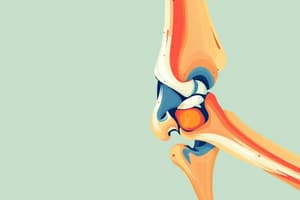Podcast
Questions and Answers
What type of joint is characterized by the articulating bones being separated by cartilage and allowing slight mobility?
What type of joint is characterized by the articulating bones being separated by cartilage and allowing slight mobility?
- Fibrous joints
- Secondary cartilaginous joints (correct)
- Synovial joints
- Primary cartilaginous joints (correct)
Which type of fibrous joint is known to be the most movable?
Which type of fibrous joint is known to be the most movable?
- Synchondrosis
- Syndesmosis (correct)
- Gomphoses
- Sutures
Which of the following statements accurately describes bursae?
Which of the following statements accurately describes bursae?
- They are types of fibrocartilaginous joints.
- They connect bones through hyaline cartilage.
- They are fluid-filled sacs that reduce friction in joints. (correct)
- They are synovial joints with limited movement.
What is a characteristic feature of synovial joints?
What is a characteristic feature of synovial joints?
Which of the following is an example of a secondary cartilaginous joint?
Which of the following is an example of a secondary cartilaginous joint?
Flashcards are hidden until you start studying
Study Notes
Definition and Classification of Joints
- Joints are the articulations between two or more bones.
- Classified based on function, structure, and axis of movements.
- Types based on tissue present between bones: fibrous, cartilaginous, synovial.
Fibrous Joints (Synarthrosis)
- Characterized by bones connected by fibrous tissue with limited or no movement.
- Types of fibrous joints:
- Sutures: Bones joined by a small amount of fibrous tissue, often ossifying in old age (e.g., skull bones).
- Gomphoses: Teeth roots fixed to bony sockets by periodontal ligament, allowing slight movement during chewing.
- Syndesmosis: Greater fibrous tissue connection allowing more movement (e.g., inferior tibiofibular joint).
Cartilaginous Joints (Synchondrosis)
- Bones are separated by cartilage, allowing slight mobility.
- Types of cartilaginous joints:
- Primary Cartilaginous: Joined by hyaline cartilage, immobile (e.g., epiphyseal plate of long bones), ossify with age.
- Secondary Cartilaginous (Symphysis): Joined by fibrocartilage, allows slight movement (e.g., pubic symphysis), does not ossify.
Synovial Joints
- Freely movable joints with articular surfaces covered by hyaline cartilage.
- Enclosed by a fibrous articular capsule with reinforcing ligaments.
- Contain a joint cavity filled with synovial fluid, which lubricates and nourishes the joint.
Functions of Synovial Fluid
- Lubricates articular cartilage.
- Facilitates smooth joint movement.
- Supports nutrition of cartilage, menisci, and articular discs.
Classification of Synovial Joints
- Based on the number of articulating bones, axes of movement, and shape of articulating surfaces.
- Types by articulating bones:
- Simple Joint: Two articulating bones.
- Compound Joint: More than two articulating bones (e.g., elbow joint).
- Complex Joint: Contains intracapsular articular discs or menisci (e.g., sternoclavicular joint, knee joint).
Axes of Movement
- Uni-axial Joint: Movements in one plane.
- Example: Hinge joints (e.g., elbow), Pivot joints (e.g., atlanto-axial joint).
- Bi-axial Joint: Movements in two planes.
- Example: Condyloid joints (e.g., wrist) and Saddle joints (e.g., carpometacarpal joint of the thumb).
- Poly-axial Joint: Movements in three or more planes.
- Example: Ball and socket joints (e.g., hip, shoulder).
Shape of Articulating Surfaces
- Gliding Joint: Allows smooth sliding movement (e.g., intercarpal joints).
- Additional joint types can be classified based on specific articulating surface shapes, each having unique movement capabilities.
Studying That Suits You
Use AI to generate personalized quizzes and flashcards to suit your learning preferences.





